Tools for Communicating Agricultural Drought over the Brazilian Semiarid Using the Soil Moisture Index
Abstract
1. Introduction
2. Site and Data
3. Methodology
4. Results and Discussion
4.1. Spatial Representation
4.2. Spatiotemporal Representation
4.3. Index of Stress in Agriculture
5. Conclusions
Author Contributions
Funding
Acknowledgments
Conflicts of Interest
References
- Seneviratne, S.I.; Corti, T.; Davin, E.L.; Hirschi, M.; Jaeger, E.B.; Lehner, I.; Orlowsky, B.; Teuling, A.J. Investigating soil moisture–climate interactions in a changing climate: A review. Earth Sci. Rev. 2010, 99, 125–161. [Google Scholar] [CrossRef]
- Rossato, L.; Marengo, J.A.; Angelis, C.F.; de Pires, L.B.M.; Mendiondo, E.M. Impact of soil moisture over Palmer Drought Severity Index and its future projections in Brazil. RBRH 2017, 22. [Google Scholar] [CrossRef]
- Mishra, V.; Shah, R.; Thrasher, B. Soil moisture droughts under the retrospective and projected climate in India. J. Hydrometeorol. 2014, 15, 2267–2292. [Google Scholar] [CrossRef]
- McColl, K.A.; Alemohammad, S.H.; Akbar, R.; Konings, A.G.; Yueh, S.; Entekhabi, D. The global distribution and dynamics of surface soil moisture. Nat. Geosci. 2017. [Google Scholar] [CrossRef]
- Ionita, M.; Dima, M.; Lohmann, G.; Scholz, P.; Rimbu, N. Predicting the June 2013 European flooding based on precipitation, soil moisture, and sea level pressure. J. Hydrometeorol. 2015, 16, 598–614. [Google Scholar] [CrossRef]
- Dorigo, W.; van Oevelen, P.; Wagner, W.; Drusch, M.; Mecklenburg, S.; Robock, A.; Jackson, T. A new international network for in situ soil moisture data. Eos Trans. Am. Geophys. Union 2011, 92, 141. [Google Scholar] [CrossRef]
- Champagne, C.; Rowlandson, T.; Berg, A.; Burns, T.; L’Heureux, J.; Tetlock, E.; Adams, J.R.; McNairn, H.; Toth, B.; Itenfisu, D. Satellite surface soil moisture from SMOS and Aquarius: Assessment for applications in agricultural landscapes. Int. J. Appl. Earth Obs. Geoinf. 2016, 45, 143–154. [Google Scholar] [CrossRef]
- Cammalleri, C.; Micale, F.; Vogt, J. On the value of combining different modelled soil moisture products for European drought monitoring. J. Hydrol. 2015, 525, 547–558. [Google Scholar] [CrossRef]
- Adegoke, J.O.; Carleton, A.M. Relations between soil moisture and satellite vegetation indices in the U.S. Corn Belt. J. Hydrometeorol. 2002, 3, 395–405. [Google Scholar] [CrossRef]
- Sridhar, V.; Hubbard, K.G.; You, J.; Hunt, E.D. Development of the soil moisture index to quantify agricultural drought and its “user friendliness” in severity-area-duration assessment. J. Hydrometeorol. 2008, 9, 660–676. [Google Scholar] [CrossRef]
- Hunt, E.D.; Svoboda, M.; Wardlow, B.; Hubbard, K.; Hayes, M.; Arkebauer, T. Monitoring the effects of rapid onset of drought on non-irrigated maize with agronomic data and climate-based drought indices. Agric. For. Meteorol. 2014, 191, 1–11. [Google Scholar] [CrossRef]
- Carrão, H.; Naumann, G.; Barbosa, P. Mapping global patterns of drought risk: An empirical framework based on sub-national estimates of hazard, exposure and vulnerability. Glob. Environ. Chang. 2016, 39, 108–124. [Google Scholar] [CrossRef]
- Gao, Y.; Markkanen, T.; Thum, T.; Aurela, M.; Lohila, A.; Mammarella, I.; Kämäräinen, M.; Hagemann, S.; Aalto, T. Assessing various drought indicators in representing summer drought in boreal forests in Finland. Hydrol. Earth Syst. Sci. 2016, 20, 175–191. [Google Scholar] [CrossRef]
- Albergel, C.; Dorigo, W.; Reichle, R.H.; Balsamo, G.; de Rosnay, P.; Muñoz-Sabater, J.; Isaksen, L.; de Jeu, R.; Wagner, W. Skill and global trend analysis of soil moisture from reanalyses and microwave remote sensing. J. Hydrometeorol. 2013, 14, 1259–1277. [Google Scholar] [CrossRef]
- Tomasella, J.; Hodnett, M.G.; Rossato, L. Pedotransfer functions for the estimation of soil water retention in Brazilian soils. Soil Sci. Soc. Am. J. 2000, 64, 327. [Google Scholar] [CrossRef]
- Rossato, L.; Alvala, R.C.S.; Tomasella, J. Variação espaço-temporal da umidade do solo no Brasil: Análise das condições médias para o período de 1971–1990. Rev. Bras. Meteorol. 2004, 19, 113–122. [Google Scholar]
- Rossato, L.; Alvalá, R.C.D.S.; Marengo, J.A.; Zeri, M.; Cunha, A.P.M.D.A.; Pires, L.B.M.; Barbosa, H.A. Impact of soil moisture on crop yields over Brazilian semiarid. Front. Environ. Sci. 2017, 5, 73. [Google Scholar] [CrossRef]
- Svoboda, M.; Fuchs, B.A. Handbook of Drought Indicators and Indices; World Meteorological Organization (WMO) and Global Water Partnership (GWP): Geneva, Switzerland, 2016; ISBN 978-92-63-11173-9. [Google Scholar]
- Hunt, E.D.; Hubbard, K.G.; Wilhite, D.A.; Arkebauer, T.J.; Dutcher, A.L. The development and evaluation of a soil moisture index. Int. J. Climatol. 2009, 29, 747–759. [Google Scholar] [CrossRef]
- Gao, Y.; Markkanen, T.; Aurela, M.; Mammarella, I.; Thum, T.; Tsuruta, A.; Yang, H.; Aalto, T. Response of water use efficiency to summer drought in boreal Scots pine forests in Finland. Biogeosci. Discuss. 2016, 2016, 1–18. [Google Scholar] [CrossRef]
- Bradford, K.J.; Hsiao, T.C. Physiological responses to moderate water stress. In Physiological Plant Ecology II. Water Relations and Carbon Assimilation; Lange, O.R., Ed.; Springer-Verlag: Berlin, Germany, 1982; Volume 12B, pp. 263–324. [Google Scholar]
- Bréda, N.; Granier, A. Intra- and interannual variations of transpiration, leaf area index and radial growth of a sessile oak stand (Quercus petraea). Ann. For. Sci. 1996, 53, 521–536. [Google Scholar] [CrossRef]
- Granier, A.; Bréda, N.; Biron, P.; Villette, S. A lumped water balance model to evaluate duration and intensity of drought constraints in forest stands. Ecol. Model. 1999, 116, 269–283. [Google Scholar] [CrossRef]
- Pataki, D.E.; Oren, R. Species differences in stomatal control of water loss at the canopy scale in a mature bottomland deciduous forest. Adv. Water Resour. 2003, 26, 1267–1278. [Google Scholar] [CrossRef]
- Akuraju, V.R.; Ryu, D.; George, B.; Ryu, Y.; Dassanayake, K. Seasonal and inter-annual variability of soil moisture stress function in dryland wheat field, Australia. Agric. For. Meteorol. 2017, 232, 489–499. [Google Scholar] [CrossRef]
- Guilpart, N.; Roux, S.; Gary, C.; Metay, A. The trade-off between grape yield and grapevine susceptibility to powdery mildew and grey mould depends on inter-annual variations in water stress. Agric. For. Meteorol. 2017, 234–235, 203–211. [Google Scholar] [CrossRef]
- Moura, A.D.; Shukla, J. On the dynamics of droughts in Northeast Brazil—Observations, theory and numerical experiments with a general-circulation model. J. Atmos. Sci. 1981, 38, 2653–2675. [Google Scholar] [CrossRef]
- Hastenrath, S. Exploring the climate problems of Brazil’s Nordeste: A review. Clim. Chang. 2012, 112, 243–251. [Google Scholar] [CrossRef]
- Cunha, A.P.M.; Alvalá, R.C.; Nobre, C.A.; Carvalho, M.A. Monitoring vegetative drought dynamics in the Brazilian semiarid region. Agric. For. Meteorol. 2015, 214–215, 494–505. [Google Scholar] [CrossRef]
- Marengo, J.A.; Bernasconi, M. Regional differences in aridity/drought conditions over Northeast Brazil: Present state and future projections. Clim. Chang. 2015, 129, 103–115. [Google Scholar] [CrossRef]
- Alvalá, R.C.S.; Cunha, A.P.M.A.; Brito, S.S.B.; Seluchi, M.E.; Marengo, J.A.; Moraes, O.L.L.; Carvalho, M.A. Drought monitoring in the Brazilian Semiarid region. Anais da Academia Brasileira de Ciências 2017. [Google Scholar] [CrossRef]
- Brito, S.S.B.; Cunha, A.P.M.A.; Cunningham, C.C.; Alvalá, R.C.; Marengo, J.A.; Carvalho, M.A. Frequency, duration and severity of drought in the Semiarid Northeast Brazil region. Int. J. Climatol. 2017, 38, 517–529. [Google Scholar] [CrossRef]
- Marengo, J.A.; Alves, L.M.; Alvala, R.C.S.; Cunha, A.P.; Brito, S.; Moraes, O.L.L. Climatic characteristics of the 2010–2016 drought in the semiarid Northeast Brazil region. Anais da Academia Brasileira de Ciências 2017. [Google Scholar] [CrossRef] [PubMed]
- Marengo, J.A.; Torres, R.R.; Alves, L.M. Drought in Northeast Brazil—Past, present, and future. Theor. Appl. Climatol. 2017, 129, 1189–1200. [Google Scholar] [CrossRef]
- Menezes, J.A.L.; Santos, T.E.M.; Montenegro, A.A.D.A.; Silva, J.R.L. Temporal behavior of soil water under ‘Caatinga’ and bare soil in Experimental Basin of Jatobá, Pernambuco. Water Resour. Irrig. Manag. 2013, 2, 45–51. [Google Scholar]
- Alvares, C.A.; Stape, J.L.; Sentelhas, P.C.; de Moraes Gonçalves, J.L.; Sparovek, G. Köppen’s climate classification map for Brazil. Meteorol. Z. 2013, 22, 711–728. [Google Scholar] [CrossRef]
- Kousky, V.E. Frontal influences on Northeast Brazil. Mon. Weather Rev. 1979, 107, 1140–1153. [Google Scholar] [CrossRef]
- Chaves, R.R.; Cavalcanti, I.F.A. Atmospheric circulation features associated with rainfall variability over southern northeast Brazil. Mon. Weather Rev. 2001, 129, 2614–2626. [Google Scholar] [CrossRef]
- Nobre, P.; Marengo, J.A.; Cavalcanti, I.F.A.; Obregon, G.; Barros, V.; Camilloni, I.; Campos, N.; Ferreira, A.G. Seasonal-to-decadal predictability and prediction of South American climate. J. Clim. 2006, 19, 5988–6004. [Google Scholar] [CrossRef]
- Cavalcanti, I.F.A. Large scale and synoptic features associated with extreme precipitation over South America: A review and case studies for the first decade of the 21st century. Atmos. Res. 2012, 118, 27–40. [Google Scholar] [CrossRef]
- Kayano, M.T.; Andreoli, R.V.; Ferreira de Souza, R.A. Relations between ENSO and the South Atlantic SST modes and their effects on the South American rainfall. Int. J. Climatol. 2013, 33, 2008–2023. [Google Scholar] [CrossRef]
- Lyra, G.B.; Oliveira-Júnior, J.F.; Gois, G.; Cunha-Zeri, G.; Zeri, M. Rainfall variability over Alagoas under the influences of SST anomalies. Meteorol. Atmos. Phys. 2017, 129. [Google Scholar] [CrossRef]
- IBGE Instituto Brasileiro de Geografia e Estatística, Censo Agropecuário 2006. Available online: https://ww2.ibge.gov.br/home/estatistica/economia/agropecuaria/censoagro/default.shtm (accessed on 14 September 2018).
- Oliveira, F.T. Root System’s Growth of the Opuntia fícus-indica (L.) Mill (cactus pear) on the Basis of Population Managements and Phosphate Fertilization; Federal University of Campina Grande: Campina Grande, Brazil, 2008. [Google Scholar]
- Loiola Edvan, R.; Dantas Fernades, P.; de Souza Carneiro, M.S.; Gonçalves Neder, D.; Silva Araujo, J.; de Andrade, A.P.; Souto Filho, L.T. Biomass accumulation and root growth of cactus pear in different harvest periods. Rev. Acadêmica Ciência Anim. 2013. [Google Scholar] [CrossRef]
- Bastos, E.A.; Andrade Júnior, A.S.; Nogueira, C.C.P. Cultivo de Feijão-Caupi; Empresa Brasileira de Pesquisa Agropecuária: Brasília, Brazil, 2017. [Google Scholar]
- Dane, J.H.; Topp, G.C. Methods of Soil Analysis, Part 4; Soil Science Society of America: Madison, WI, USA, 2002. [Google Scholar]
- USDA General Guide for Estimating Moist Bulk Density. Available online: https://www.nrcs.usda.gov/wps/portal/nrcs/detail/soils/survey/office/ssr10/tr/?cid=nrcs144p2_074844 (accessed on 14 September 2018).
- Zhang, J.; Davies, W.J. Sequential response of whole plant water relations to prolonged soil drying and the involvement of xylem sap ABA in the regulation of stomatal behaviour of sunflower plants. New Phytol. 1989, 113, 167–174. [Google Scholar] [CrossRef]
- Ali, M.; Jensen, C.R.; Mogensen, V.O. Early signals in field grown wheat in response to shallow soil drying. Funct. Plant Biol. 1999, 25, 871–882. [Google Scholar] [CrossRef]
- Braatne, J.H.; Hinckley, T.M.; Stettler, R.F. Influence of soil water on the physiological and morphological components of plant water balance in Populus trichocarpa, Populus deltoides and their F1 hybrids. Tree Physiol. 1992, 11, 325–339. [Google Scholar] [CrossRef] [PubMed]
- Hsiao, T.C. Plant responses to water stress. Annu. Rev. Plant Physiol. 1973, 24, 519–570. [Google Scholar] [CrossRef]
- Chaves, M.M.; Pereira, J.S.; Maroco, J.; Rodrigues, M.L.; Ricardo, C.P.P.; OsÓRio, M.L.; Carvalho, I.; Faria, T.; Pinheiro, C. How plants cope with water stress in the field? Photosynthesis and growth. Ann. Bot. 2002, 89, 907–916. [Google Scholar] [CrossRef] [PubMed]
- G1 Seca no Nordeste Bate Recorde e afeta a Produção Agrícola. Available online: http://g1.globo.com/bom-dia-brasil/noticia/2016/10/seca-no-nordeste-bate-recorde-e-afeta-producao-agricola.html (accessed on 14 September 2018).
- Diário_do_Nordeste Seca de 2016 no Ceará Está Entre as Piores da História; Veja a Lista. Available online: http://diariodonordeste.verdesmares.com.br/cadernos/regional/online/seca-de-2016-no-ceara-esta-entre-as-piores-da-historia-veja-a-lista-1.1565486 (accessed on 14 September 2018).
- CONAB. Acompanhamento da Safra Brasileira de Grãos—Safra 2015/2016; Companhia Nacional de Abastecimento: Brasília, Brazil, 2016; Volume 3.
- Wilhite, D.A.; Sivakumar, M.V.K.; Pulwarty, R. Managing drought risk in a changing climate: The role of national drought policy. Weather Clim. Extrem. 2014, 3, 4–13. [Google Scholar] [CrossRef]
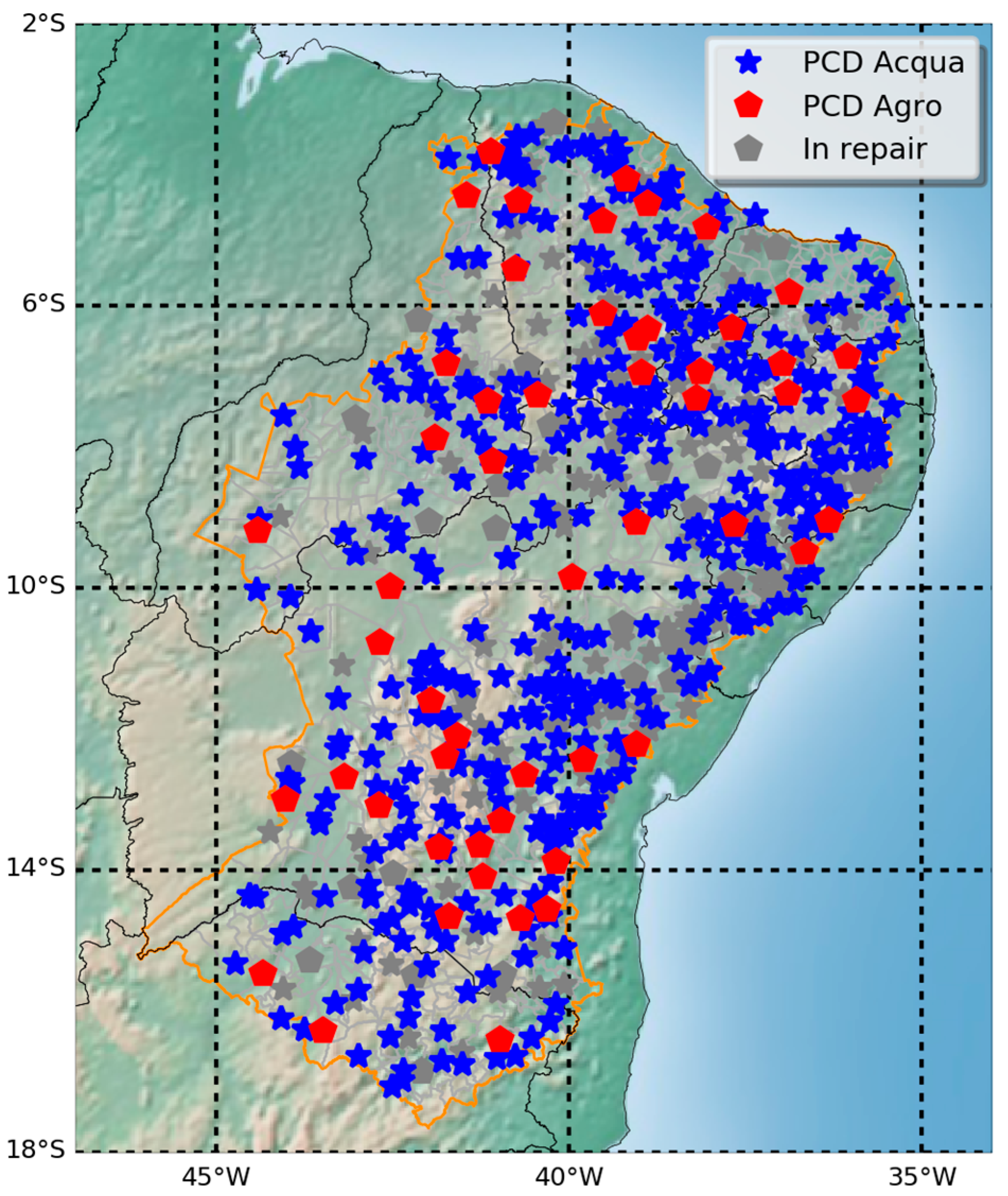

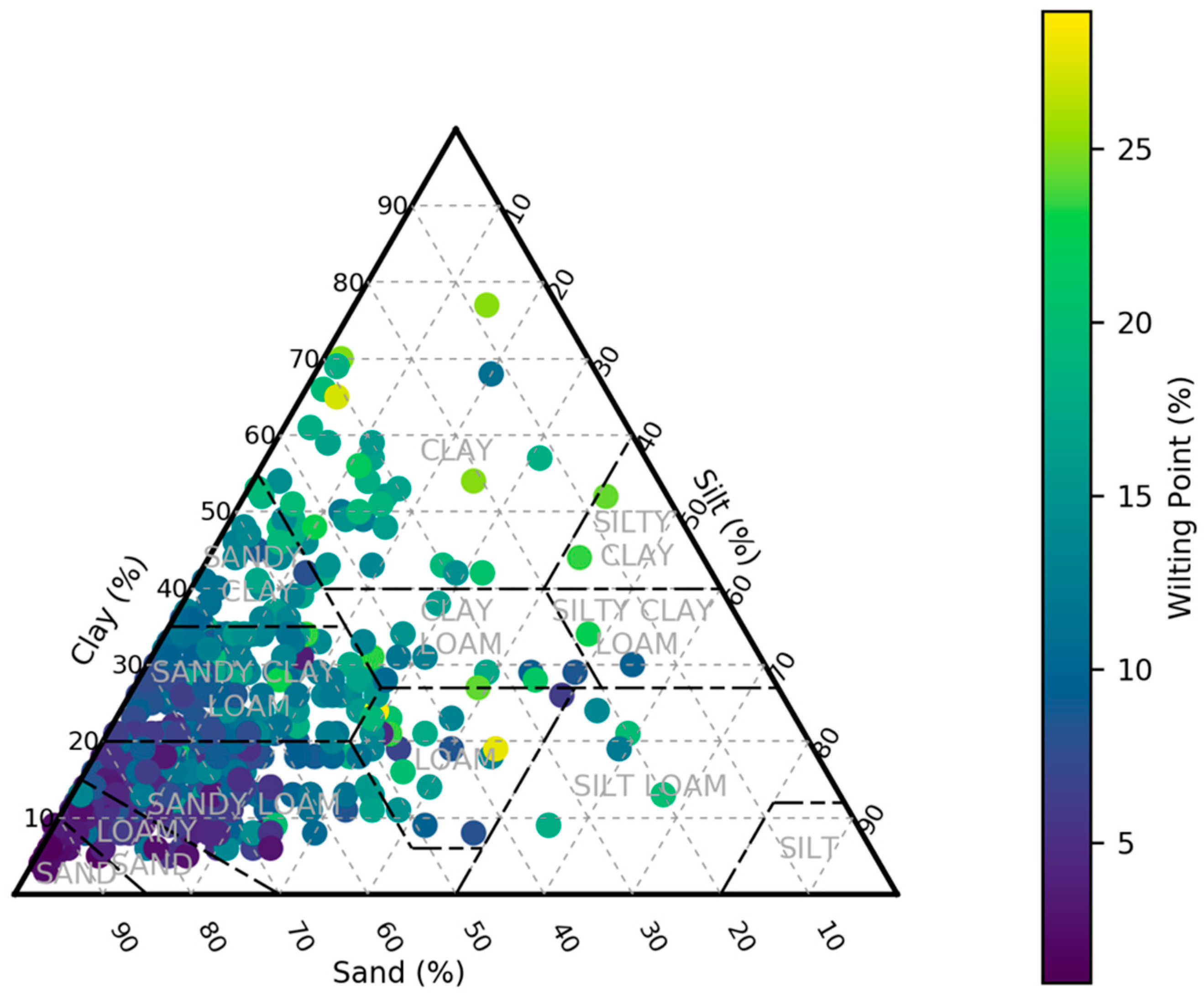
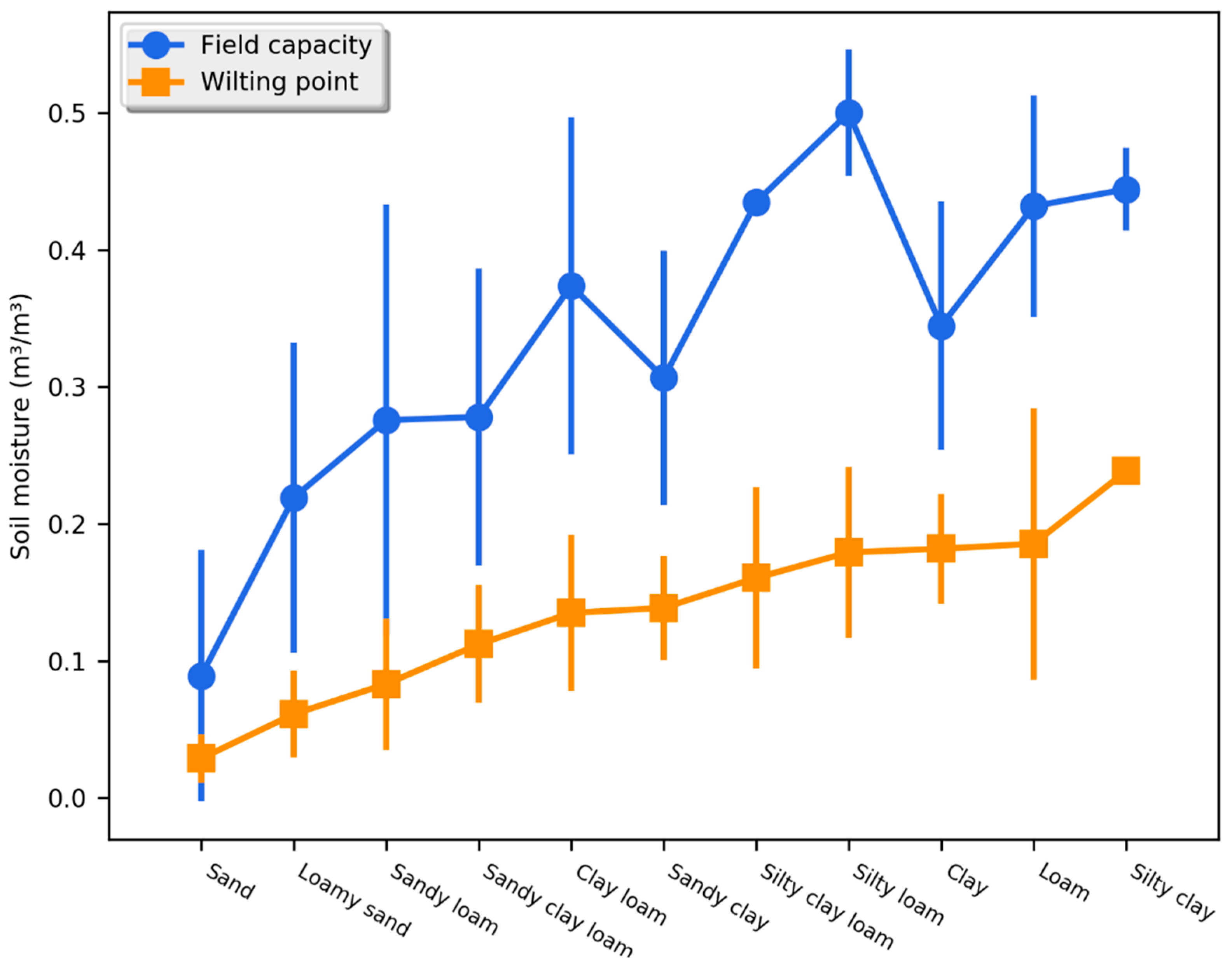
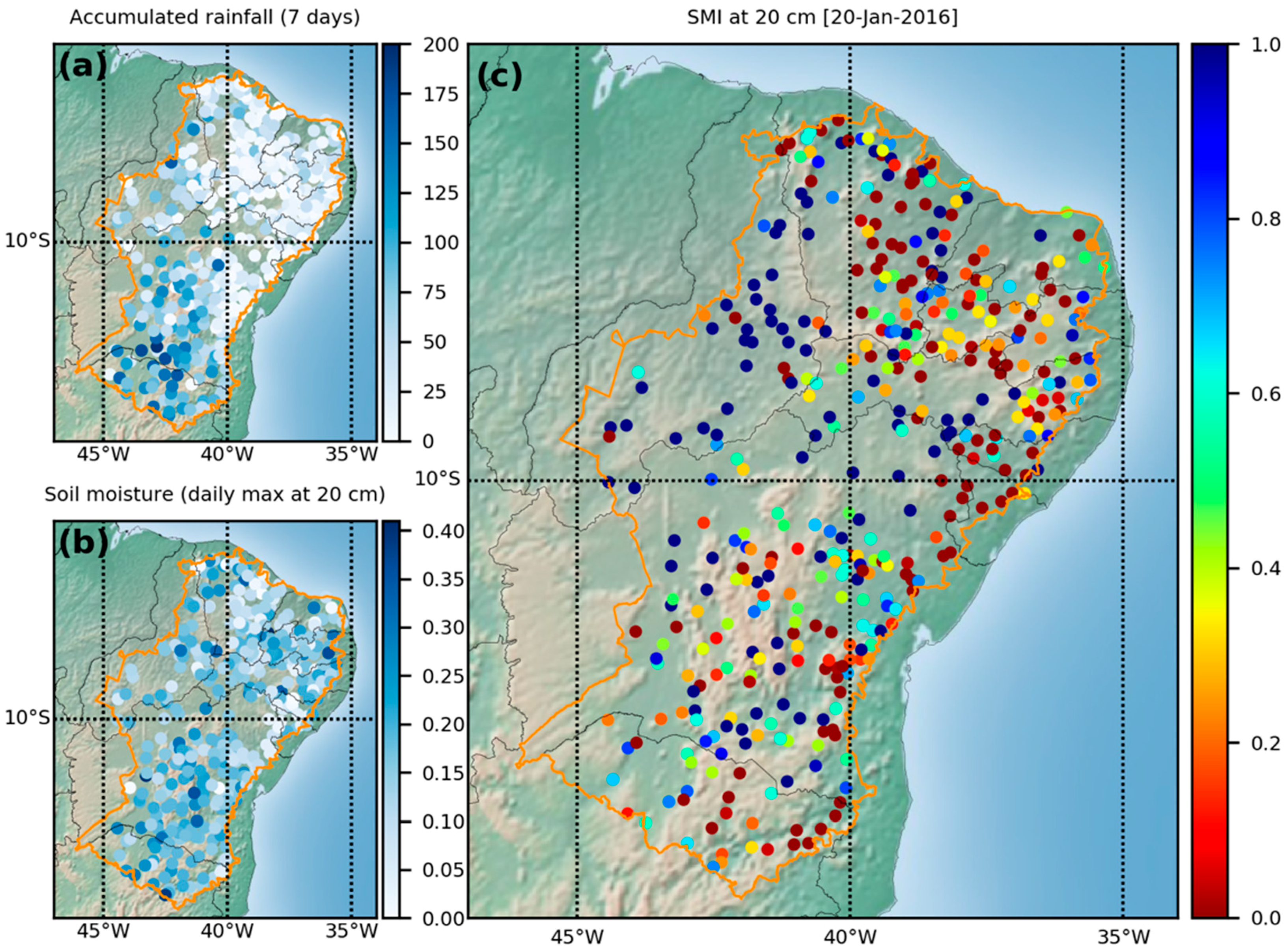
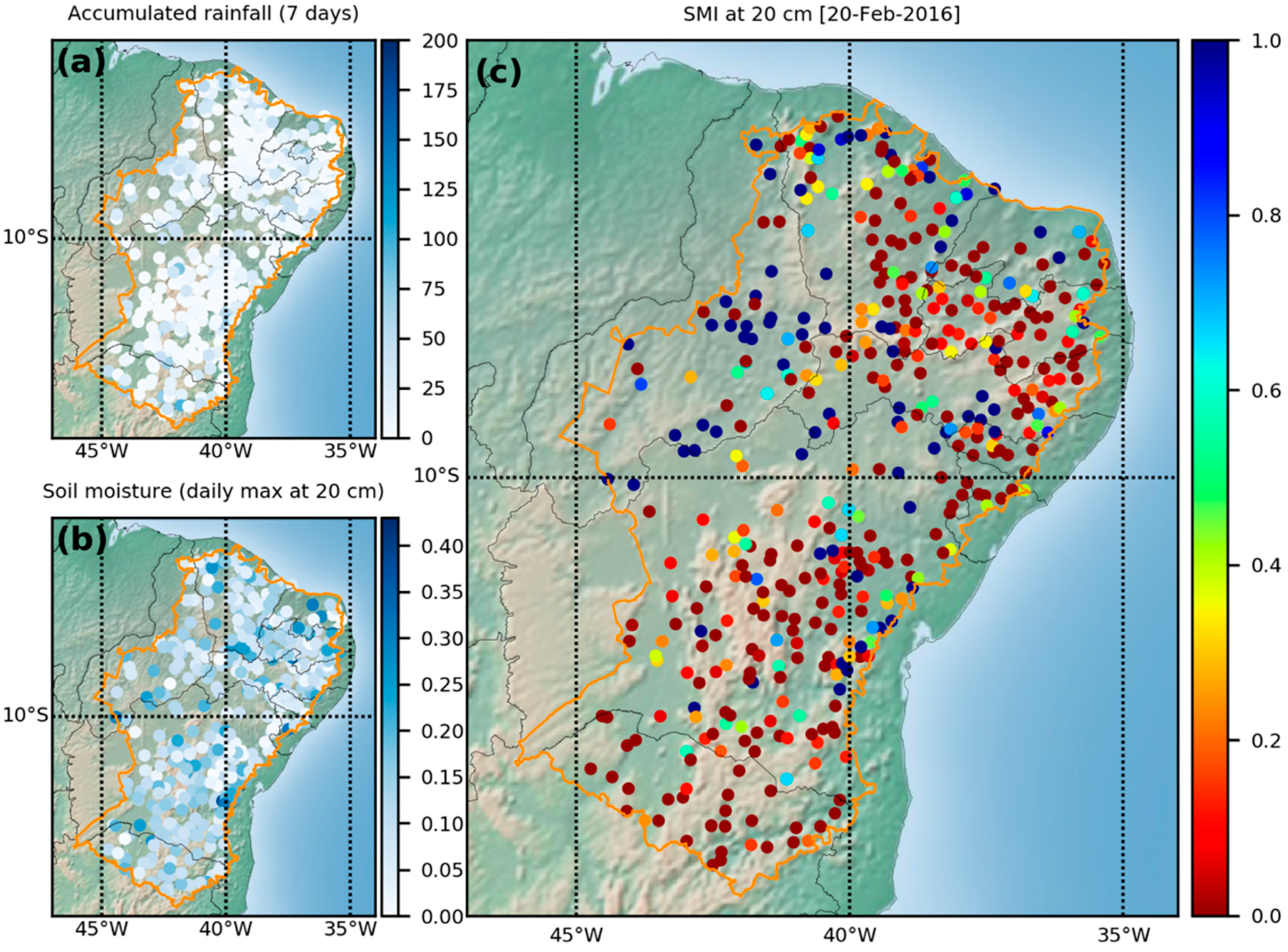
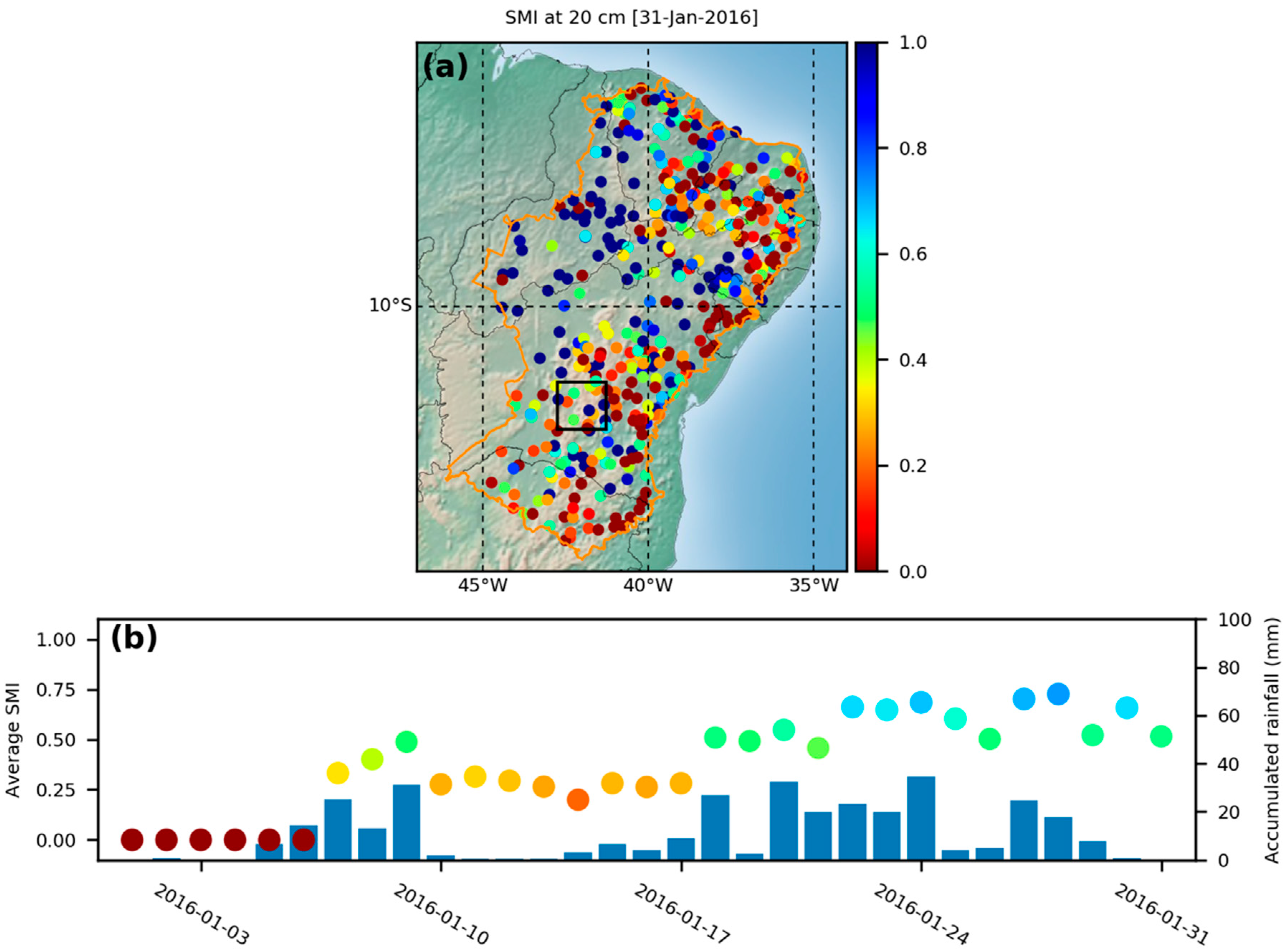
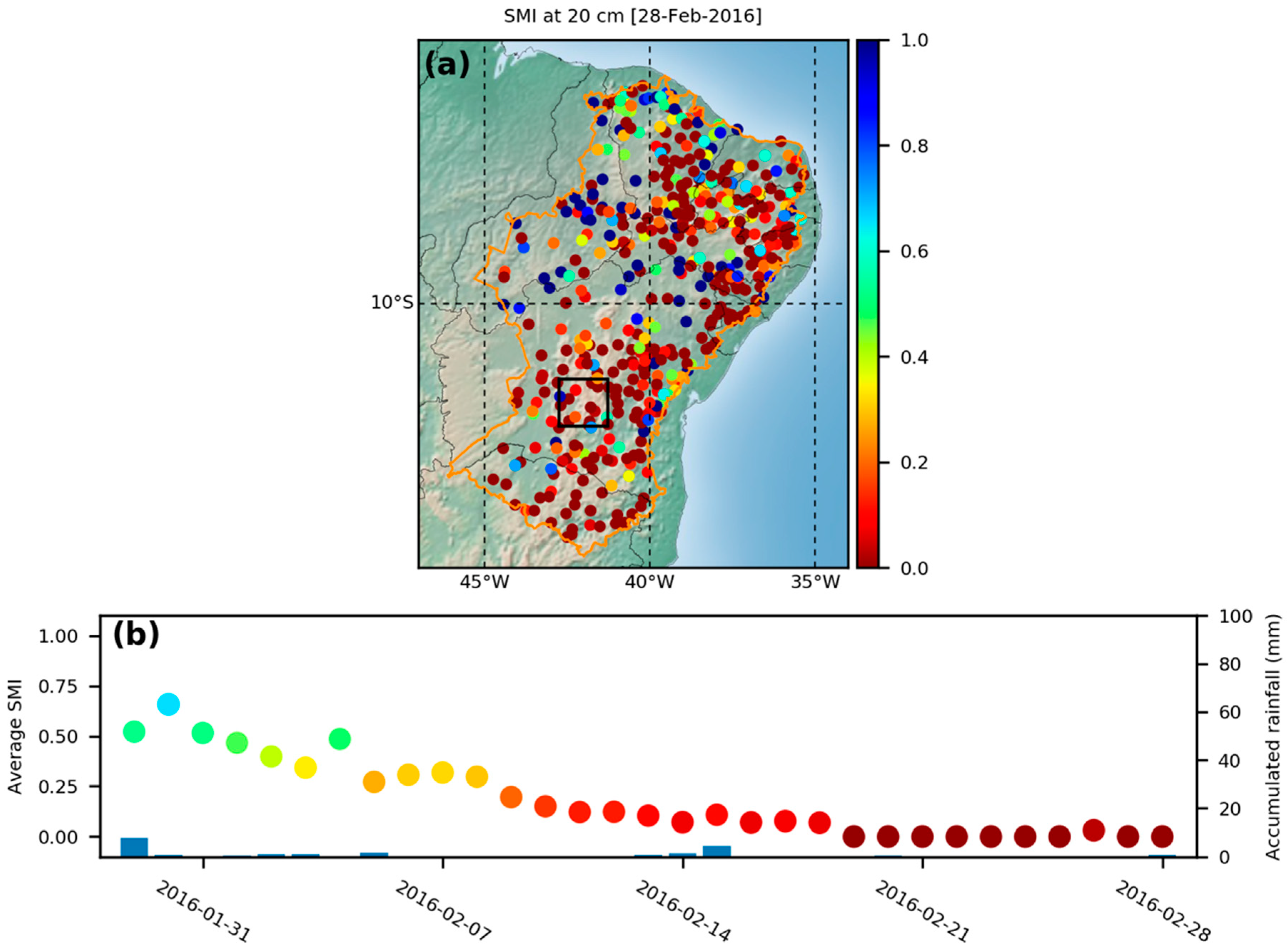
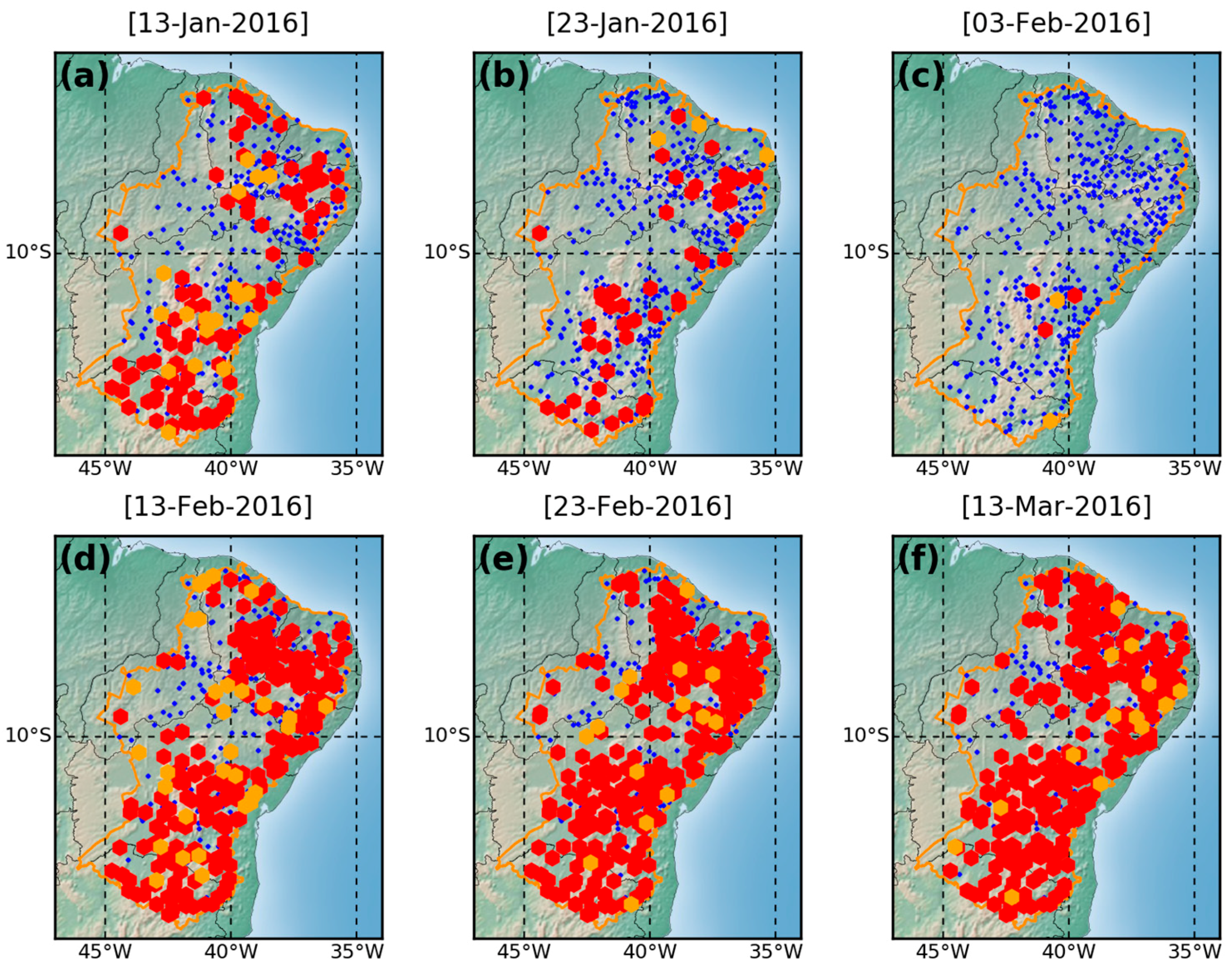
| Texture Class | Bulk Density (g cm−3) |
|---|---|
| Sand | 1.65 |
| Loamy sand | 1.6 |
| Sandy loam | 1.55 |
| Loam | 1.5 |
| Sandy clay loam | 1.5 |
| Silty clay loam | 1.5 |
| Silty loam | 1.5 |
| Clay loam | 1.45 |
| Silty clay | 1.45 |
| Sandy clay | 1.4 |
| Clay | 1.35 |
© 2018 by the authors. Licensee MDPI, Basel, Switzerland. This article is an open access article distributed under the terms and conditions of the Creative Commons Attribution (CC BY) license (http://creativecommons.org/licenses/by/4.0/).
Share and Cite
Zeri, M.; S. Alvalá, R.C.; Carneiro, R.; Cunha-Zeri, G.; Costa, J.M.; Rossato Spatafora, L.; Urbano, D.; Vall-Llossera, M.; Marengo, J. Tools for Communicating Agricultural Drought over the Brazilian Semiarid Using the Soil Moisture Index. Water 2018, 10, 1421. https://doi.org/10.3390/w10101421
Zeri M, S. Alvalá RC, Carneiro R, Cunha-Zeri G, Costa JM, Rossato Spatafora L, Urbano D, Vall-Llossera M, Marengo J. Tools for Communicating Agricultural Drought over the Brazilian Semiarid Using the Soil Moisture Index. Water. 2018; 10(10):1421. https://doi.org/10.3390/w10101421
Chicago/Turabian StyleZeri, Marcelo, Regina Célia S. Alvalá, Rogério Carneiro, Gisleine Cunha-Zeri, José Maria Costa, Luciana Rossato Spatafora, Domingos Urbano, Mercè Vall-Llossera, and José Marengo. 2018. "Tools for Communicating Agricultural Drought over the Brazilian Semiarid Using the Soil Moisture Index" Water 10, no. 10: 1421. https://doi.org/10.3390/w10101421
APA StyleZeri, M., S. Alvalá, R. C., Carneiro, R., Cunha-Zeri, G., Costa, J. M., Rossato Spatafora, L., Urbano, D., Vall-Llossera, M., & Marengo, J. (2018). Tools for Communicating Agricultural Drought over the Brazilian Semiarid Using the Soil Moisture Index. Water, 10(10), 1421. https://doi.org/10.3390/w10101421








